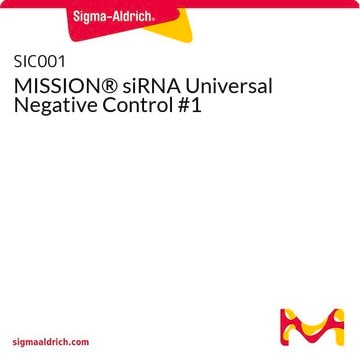As per the product information sheet, 100% Ethanol is suggested for the dilution of the wash solution. The use of 100% methanol has not been validated and is not recommended for the isolation of RNA. Kindly review the product information sheet available at this link: https://www.sigmaaldrich.com/deepweb/assets/sigmaaldrich/product/documents/188/017/snc10bul.pdf
SNC50
mirPremier® microRNA Isolation Kit
1 sufficient for 50 preparations
Synonym(s):
microRNA Isolation Kit
About This Item
Recommended Products
Looking for similar products? Visit Product Comparison Guide
General description
.
Application
Features and Benefits
- Designed to enhance the efficiency of isolating microRNA and other small RNA molecules directly from a wide range of biological sources.
- Enables fast and efficient extraction and concentration of miRNA in 30 minutes for downstream applications.
- Can extract high-purity miRNA with no detectable large RNA
- No dangerous organic extractions are involved.
Legal Information
related product
Signal Word
Warning
Hazard Statements
Precautionary Statements
Hazard Classifications
Acute Tox. 4 Inhalation - Acute Tox. 4 Oral - Eye Irrit. 2 - Skin Irrit. 2
Storage Class Code
10 - Combustible liquids
Flash Point(F)
Not applicable
Flash Point(C)
Not applicable
Choose from one of the most recent versions:
Certificates of Analysis (COA)
Don't see the Right Version?
If you require a particular version, you can look up a specific certificate by the Lot or Batch number.
Already Own This Product?
Find documentation for the products that you have recently purchased in the Document Library.
Articles
Simple DNA/RNA purification methods aid genome analysis from various sources, enhancing research efficiency.
Simple DNA/RNA purification methods aid genome analysis from various sources, enhancing research efficiency.
Simple DNA/RNA purification methods aid genome analysis from various sources, enhancing research efficiency.
Simple DNA/RNA purification methods aid genome analysis from various sources, enhancing research efficiency.
Related Content
Sigma-Aldrich® Advanced Genomics is the leading provider of gene editing and silencing technologies including CRISPR, Cas9, synthetic guide RNA (sgRNA), and Zinc Finger Nuclease (ZFN).
Sigma-Aldrich® Advanced Genomics is the leading provider of gene editing and silencing technologies including CRISPR, Cas9, synthetic guide RNA (sgRNA), and Zinc Finger Nuclease (ZFN).
Sigma-Aldrich® Advanced Genomics is the leading provider of gene editing and silencing technologies including CRISPR, Cas9, synthetic guide RNA (sgRNA), and Zinc Finger Nuclease (ZFN).
Sigma-Aldrich® Advanced Genomics is the leading provider of gene editing and silencing technologies including CRISPR, Cas9, synthetic guide RNA (sgRNA), and Zinc Finger Nuclease (ZFN).
-
Methanol 100% can be used for the dilution of the wash solution instead of ethanol 100%?
1 answer-
Helpful?
-
-
Can I purify 18S and 28S large RNAs along with miRNAs with the mirPremier® microRNA Isolation Kit?
1 answer-
Large RNAs (18S and 28S) from the pellet fraction can be purified after transferring the microRNA-containing supernatant to a new tube by using the total RNA protocol or by phenol/chloroform extraction.
Helpful?
-
-
How can I avoid co-purifying mRNAs and rRNAs when purifying small RNAs from gram negative bacteria using mirPremier® microRNA Isolation Kit?
1 answer-
Too much residual medium or cell mass may lead to recovery of some large RNAs. It is critical to remove as much residual medium as possible by re-centrifuging the pellet. One can also test different ratios of the lysis mix (Small RNA Lysis Buffer and Binding Solution).
Helpful?
-
-
Can the mirPremier® microRNA Isolation Kit be used to isolate small RNAs from purified total RNA?
1 answer-
We have used to the kit to purify in vitro transcribed small RNAs with great success, but have not done so with purified total RNA. Here are the steps we would recommend trying with purified total RNA:1. Prepare a lysis mix with 0.7 vol. Small RNA Lysis Buffer (M1070) and 0.3 vol. Binding Solution (L8042).2. Add 500 ul of lysis mix with 50 ul total RNA and mix thoroughly.3. Spin at 14000 rpm for 5 min to precipitate large RNA.5. Transfer the supernatant to a new tube.6. Add 610 ul (1.1 vol.) 100% ethanol to the supernatant and mix well.7.Transfer the mixture to a binding column and spin 1 min to bind. Repeat the binding step with the remaining mixture.8. Wash the column first with 700 ul 100% ethanol, and then with ethanol-diluted wash Solution 2.9. Dry the column and elute small RNA.
Helpful?
-
-
Has the mirPremier® microRNA Isolation Kit been tested on sperm cells?
1 answer-
We have not tested mirPremier™ microRNA Isolation Kit with sperm cells.
Helpful?
-
Active Filters
Our team of scientists has experience in all areas of research including Life Science, Material Science, Chemical Synthesis, Chromatography, Analytical and many others.
Contact Technical Service









